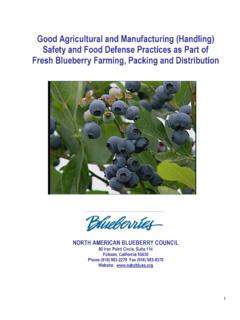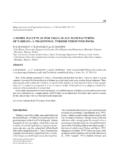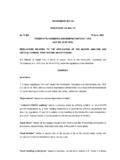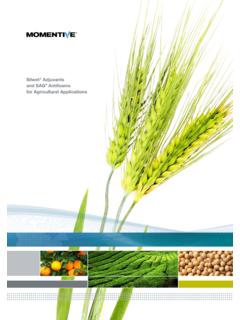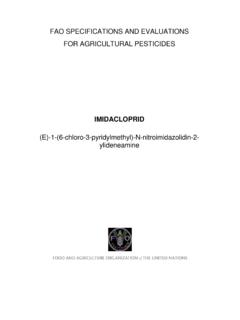Transcription of Subpart A-General Provisions PART 110-CURRENT …
1 21 cfr part 110 PART 110-CURRENT GOODMANUFACTURING PRACTICE INMANUFACTURING, PACKING, OR HOLDINGHUMAN FOODS ubpart A-General Current good manufacturing B-Buildings and Plant and Sanitary Sanitary facilities and Equipment and D[Reserved] Subpart E-Production and Process Processes and Warehousing and F[Reserved] Subpart G-Defect Action Natural or unavoidable defects in food forhuman use that present no health : 21 342, 371, 374; 42 : 51 FR 24475, June 19, 1986, unless cfr ubpartA_P 110 Subpart A-General Provisions21 cfr definitions and interpretations of terms in section201 of the Federal Food, Drug, and Cosmetic Act (theact) are applicable to such terms when used in this following definitions shall also apply:(a) Acid foods or acidified foods means foods that havean equilibrium pH of or below.(b) Adequate means that which is needed toaccomplish the intended purpose in keeping with goodpublic health ) Batter means a semifluid substance, usuallycomposed of flour and other ingredients, into whichprincipal components of food are dipped or with whichthey are coated, or which may be used directly to formbakery foods.
2 (d) Blanching, except for tree nuts and peanuts, meansa prepackaging heat treatment of foodstuffs for asufficient time and at a sufficient temperature topartially or completely inactivate the naturallyoccurring enzymes and to effect other physical orbiochemical changes in the food.(e) Critical control point means a point in a foodprocess where there is a high probability that impropercontrol may cause, allow, or contribute to a hazard orto filth in the final food or decomposition of the finalfood.(f) Food means food as defined in section 201(f) of theact and includes raw materials and ingredients.(g) Food-contact surfaces are those surfaces thatcontact human food and those surfaces from whichdrainage onto the food or onto surfaces that contact thefood ordinarily occurs during the normal course ofoperations. "Food-contact surfaces" includes utensilsand food-contact surfaces of equipment.
3 (h) Lot means the food produced during a period oftime indicated by a specific code.(i) Microorganisms means yeasts, molds, bacteria, andviruses and includes, but is not limited to, specieshaving public health significance. The term"undesirable microorganisms" includes thosemicroorganisms that are of public health significance,that subject food to decomposition, that indicate thatfood is contaminated with filth, or that otherwise maycause food to be adulterated within the meaning of theact. Occasionally in these regulations, FDA used theadjective "microbial" instead of using an adjectivalphrase containing the word microorganism.(j) Pest refers to any objectionable animals or insectsincluding, but not limited to, birds, rodents, flies, andlarvae.(k) Plant means the building or facility or parts thereof,used for or in connection with the manufacturing ,packaging, labeling, or holding of human food.
4 (l) Quality control operation means a planned andsystematic procedure for taking all actions necessary toprevent food from being adulterated within themeaning of the act.(m) Rework means clean, unadulterated food that hasbeen removed from processing for reasons other thaninsanitary conditions or that has been successfullyreconditioned by reprocessing and that is suitable foruse as food.(n) Safe-moisture level is a level of moisture lowenough to prevent the growth of undesirablemicroorganisms in the finished product under theintended conditions of manufacturing , storage, anddistribution. The maximum safe moisture level for afood is based on its water activity (aw). An aw will beconsidered safe for a food if adequate data areavailable that demonstrate that the food at or below thegiven aw will not support the growth of undesirablemicroorganisms.(o) Sanitize means to adequately treat food-contactsurfaces by a process that is effective in destroyingvegetative cells of microorganisms of public healthsignificance, and in substantially reducing numbers ofother undesirable microorganisms, but withoutadversely affecting the product or its safety for theconsumer.
5 (p) Shall is used to state mandatory requirements.(q) Should is used to state recommended or advisoryprocedures or identify recommended equipment.(r) Water activity (aw) is a measure of the freemoisture in a food and is the quotient of the watervapor pressure of the substance divided by the vaporpressure of pure water at the same cfr Current good manufacturing practice.(a) The criteria and definitions in this part shall applyin determining whether a food is adulterated (1) withinthe meaning of section 402(a)(3) of the act in that thefood has been manufactured under such conditions thatit is unfit for food; or (2) within the meaning of section402(a)(4) of the act in that the food has been prepared,packed, or held under insanitary conditions whereby itmay have become contaminated with filth, or wherebyit may have been rendered injurious to health. Thecriteria and definitions in this part also apply indetermining whether a food is in violation of section361 of the Public Health Service Act (42 264).
6 (b) Food covered by specific current goodmanufacturing practice regulations also is subject tothe requirements of those cfr plant management shall take all reasonablemeasures and precautions to ensure the following:(a) Disease control. Any person who, by medicalexamination or supervisory observation, is shown tohave, or appears to have, an illness, open lesion,including boils, sores, or infected wounds, or any otherabnormal source of microbial contamination by whichthere is a reasonable possibility of food, food-contactsurfaces, or food-packaging materials becomingcontaminated, shall be excluded from any operationswhich may be expected to result in such contaminationuntil the condition is corrected. Personnel shall beinstructed to report such health conditions to theirsupervisors.(b) Cleanliness. All persons working in direct contactwith food, food-contact surfaces, and food-packagingmaterials shall conform to hygienic practices while onduty to the extent necessary to protect againstcontamination of food.
7 The methods for maintainingcleanliness include, but are not limited to:(1) Wearing outer garments suitable to the operation ina manner that protects against the contamination offood, food-contact surfaces, or food-packagingmaterials.(2) Maintaining adequate personal cleanliness.(3) Washing hands thoroughly (and sanitizing ifnecessary to protect against contamination withundesirable microorganisms) in an adequate hand-washing facility before starting work, after eachabsence from the work station, and at any other timewhen the hands may have become soiled orcontaminated.(4) Removing all unsecured jewelry and other objectsthat might fall into food, equipment, or containers, andremoving hand jewelry that cannot be adequatelysanitized during periods in which food is manipulatedby hand. If such hand jewelry cannot be removed, itmay be covered by material which can be maintainedin an intact, clean, and sanitary condition and whicheffectively protects against the contamination by theseobjects of the food, food-contact surfaces, or food-packaging materials.
8 (5) Maintaining gloves, if they are used in foodhandling, in an intact, clean, and sanitary gloves should be of an impermeable material.(6) Wearing, where appropriate, in an effectivemanner, hair nets, headbands, caps, beard covers, orother effective hair restraints.(7) Storing clothing or other personal belongings inareas other than where food is exposed or whereequipment or utensils are washed.(8) Confining the following to areas other than wherefood may be exposed or where equipment or utensilsare washed: eating food, chewing gum, drinkingbeverages, or using tobacco.(9) Taking any other necessary precautions to protectagainst contamination of food, food-contact surfaces,or food-packaging materials with microorganisms orforeign substances including, but not limited to,perspiration, hair, cosmetics, tobacco, chemicals, andmedicines applied to the skin.
9 (c) Education and training. Personnel responsible foridentifying sanitation failures or food contaminationshould have a background of education or experience,or a combination thereof, to provide a level ofcompetency necessary for production of clean and safefood. Food handlers and supervisors should receiveappropriate training in proper food handling techniquesand food-protection principles and should be informedof the danger of poor personal hygiene and insanitarypractices.(d) Supervision. Responsibility for assuringcompliance by all personnel with all requirements ofthis part shall be clearly assigned to competentsupervisory personnel. [51 FR 24475, June 19, 1986, as amended at 54 FR24892, June 12, 1989]21 cfr Exclusions.(a) The following operations are not subject to thispart: Establishments engaged solely in the harvesting,storage, or distribution of one or more "rawagricultural commodities," as defined in section 201(r)of the act, which are ordinarily cleaned, prepared,treated, or otherwise processed before being marketedto the consuming public.
10 (b) FDA, however, will issue special regulations if it isnecessary to cover these excluded cfr ubpartB_P 110 Subpart B-Buildings and Facilities21 cfr Plant and grounds.(a) Grounds. The grounds about a food plant under thecontrol of the operator shall be kept in a condition thatwill protect against the contamination of food. Themethods for adequate maintenance of grounds include,but are not limited to:(1) Properly storing equipment, removing litter andwaste, and cutting weeds or grass within the immediatevicinity of the plant buildings or structures that mayconstitute an attractant, breeding place, or harboragefor pests.(2) Maintaining roads, yards, and parking lots so thatthey do not constitute a source of contamination inareas where food is exposed.(3) Adequately draining areas that may contributecontamination to food by seepage, foot-borne filth, orproviding a breeding place for pests.(4) Operating systems for waste treatment and disposalin an adequate manner so that they do not constitute asource of contamination in areas where food the plant grounds are bordered by grounds not underthe operator's control and not maintained in the mannerdescribed in paragraph (a) (1) through (3) of thissection, care shall be exercised in the plant byinspection, extermination, or other means to excludepests, dirt, and filth that may be a source of foodcontamination.










